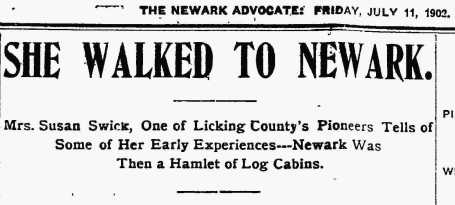This week, I’m going to write about my 4x great grandmother’s pioneer journey to Ohio in the early 1800’s and one of my favorite family history resources, newspapers.
Susan Jane (Shaffer) Swick was born in December 1818 in Fredericktown, Maryland, the daughter of John C Shaffer and Anna Haskinson Hayes. Her family moved to Ohio in 1836, when Susan was 18 years old, and settled in Licking County, where she would live for the rest of her life. In 1843, Susan married David Swick, and they eventually had six children. Their two youngest, David Jacob Swick and Susan Elizabeth Haskinson Swick, were twins. One of these twins, David, is my 3x great grandfather.
One of my favorite family history resources for my research on my dad’s side of the family is the newspapers from Newark in Licking County, Ohio (The Newark Advocate, The Newark Daily Advocate, etc. – it’s undergone a few slight name changes), that has been digitized and is available on Ancestry.com. I’ve had family in Licking County from the early 1800’s all the way through to my great grandmother who lived there until she died just a few months ago, and Ancestry.com has newspapers from about the 1860’s until at least the 1970’s, if my memory’s correct. In addition to obituaries, birth announcements, and wedding announcements, I’ve found a bounty of other information that helps to give me a much fuller picture of my Licking County ancestors. The advertisements include pictures of the kinds of clothes my ancestors probably wore and the kinds of household goods they used. The Advocate is a small town newspaper, and in addition to bigger national and world events, it usually carried a page or two about social events happening in town, which seem a lot like the Facebook status updates of 100 years ago. These are things like:
- “Mrs. Smith received a visit from daughter Susie on Sunday.”
- “A birthday celebration was held for John Doe at his home on Friday evening. His mother served a delicious dinner, and Bobby X, Billy Y, Jimmy Z attended in addition to his family.”
- “Little Susie Q came down with pneumonia on Wednesday. She was attended by Dr. X for the next several days and is now fully recovered.”
- “The Methodist Women’s Circle met on Monday. Mrs. Smith hosted and those in attendance were [long list of women’s names].”
These short stories help me to see who were my ancestor’s closest friends, which family members they saw most often, what kinds of things they did for fun, and what illnesses and hardships they faced. Sometimes it allows me to see the slowly worsening health of a person in the months before they died. And occasionally, I come across article featuring the life story of one of my ancestors.
One such article is “She Walked to Newark”, published on Friday, July 11, 1902 in the Newark Advocate. This article details her journey to Ohio and life as a pioneer in Licking County, based on an interview conducted when she was 84 years old. Here is an excerpt from the article:
She came to Licking county with her parents when eighteen years old, in 1836, walking every step of the way 356 miles, and she made her home in Licking county ever since, a period of 66 years…When Mrs. Swick first came to Licking county in 1836 it was yet almost a wilderness, and Newark was but a small hamlet containing a few log cabins. Mrs. Swick’s parents first purchased a few acres of timber land in Jersey township for $300. With willing hearts and sturdy arms they soon cleared it off, chopping the trees into timber, erecting necessary buildings, fences, etc. surrounding it. They then bought another fifty acres of land adjoining their first purchase for $400, which they also cleared in a comparatively short time. Mrs. Swick helped to clear the entire tract of land, male help being scarce in those days and hard to get. She rolled logs, cleared underbrush, worked in the fields and helped to move the goods to the cabin in the woods on a sled. She also pitched hay and raked wheat in harvest time and made herself generally useful wherever she could. It was quite evident that the pioneer women of those days had good constitutions, were not afraid to work and did not know the meaning of nervous prostration. Her husband, like most men of that time, in addition to being a hard worker, was a great hunter, in which pursuit he was very successful. He killed deer and turkey, frequently shooting some three and four wild turkeys in a day. They made delicious eating, and the pioneers had many a feast in the woods.
With this description, I can pretty easily picture much of Susan’s daily life at that time in my head. What hard work her family had to do to make a home for themselves in the woodland wilderness, where the largest town in the area was still just a “hamlet of log cabins”! Many of my other ancestors were early Ohio pioneers, and surely had similar experiences. I often feel like moving is such a hassle for me, but it’s nothing compared to the moves made by these pioneers who first walked hundreds of miles, and then had to clear land and build a house. I have such respect for these pioneers who made so many sacrifices and put in so much hard work to make a better life for their families.
